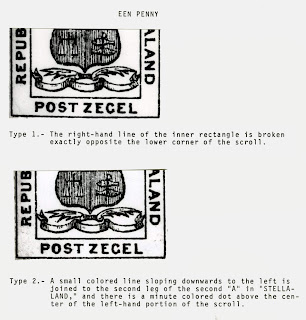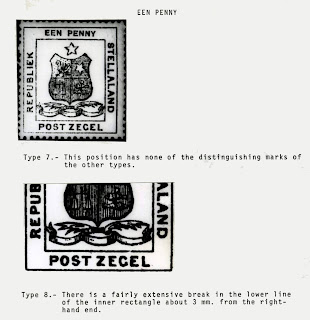The Republic of Stellaland was formed on August 7, 1883 by a party of mercenaries who supported Massouw, the Chief of the Batlapins, against his rival Maakoroane.
The capital was established at Vrijburg (later spelled Vryburg).
General Sir Charles Warren and 3,000 troops occupied Vryburg on February 7, 1885.
The Proclamation of September 30, 1885 ended the Republic by formally incorporating it into the newly established British Bechuanaland.
In late 1883 an order for stamps was placed with Van der Sandt, de Villiers & Co., printers of the Volks Blad in Cape town.
The stamps were lithographed in the manner usual for the period.
A die was engraved of the 6d value , from this a horizontal strip of nine impressions was taken which was transferred to the stone, and this was repeated 13 times to print a sheet of 117 stamps (13 rows of 9).
The stones for the other four values were similarly made, the dies employed being subsidiary ones produced from the original 6d die with the value tablet altered for the different denominations.
The arrangements were altered to give eight impressions repeated twelve times for 96 stamps.
These were delivered in February 1884 to Hr. M. C. Genis of Christiana.
The first reported use (per H. R. Holmes) was February 29, 1884.
The use of the stamps was discontinued after the Bechuanaland Border Police took over mail service (August 15, 1885). The stamps continued to be sold to collectors until October 31 , 1886 when the remainder was sold to Messrs Whitfield King & Co.in Ipswich for £250 with quantities consisting of 1d (621) 3d (10,514) 4d (11,762) 6d (9566) 1s (4329)
Period catalogs note that about 1000 sheets of each stamp were printed.
Perforated 11½, (forgeries generally 13, 13.5) no watermark, lithographed on bluish to white paper.
1 penny red
3 pence orange
4 pence gray
6 pence lilac
1 shilling green
2 pence on 4 pence gray overprinted “Twee”. This stamp is disputed as being a genuine issue. The ‘Twee’ overprint may have been "created" by the postmaster of Vrijburg. It is noted that only 384 were printed.
Genuine stamp features
3. 2 lines protrude in the star with the top one longer
4. Another wide space
5. Curved leg of the N
6. The E is slanted backwards
7. 2 tiny colour dots
8. The tips do not touch the ribbon except on the far right one
9. Knob of colour on the R
10. All the E’s have a longer lower leg
11. A dot of colour below the E
12. Narrow space between the I & E
13. Thickened ends on the legs of the E
14. The 7th vertical line in the lower right quadrant of the shield crosses into the quadrant above
Note all may not apply to every genuine stamp
There is a large spot of white bottom left of the star
Pairs with no joining perfs are not scarce and are found in all the values except the 1s
Note all may not apply to every genuine stamp
As well the 1s has 2 other characteristics
The first E is higherThere is a large spot of white bottom left of the star
Genuine Types
One way that does not exist in forgeries and especially reprints is to determine the original types by their flaws
So the following is a list of these (the EEN SHILLING was not located)
Clicking on images brings up the full original
ENN PENCE
DRIE PENCE
VIER PENCE
ZES PENCE
Above a Type 5 and Type 6 joined
A forgery from the Fournier Geneva Collection
Reprint/Forgeries
This is a serious issue for collectors as only a measurement of the value tablet can be of help so buying online poses a problem.
One of the original lithograph stones was somehow obtained from the printing company.
As the value tablet was not part of the stone, the forgers used the length of the ZES PENCE to determine the size of the value tablets. As a result, except for the sixpence, the value tablets of the other four denominations are shorter than those found on the genuine stamps and can be used to identify these otherwise difficult forgeries.
Value Genuine/mm Forgery/mm
EEN PENNY 13.5 12.5
DRIE PENCE 14.5 13.5
VIER PENCE 15 13.5
ZES PENCE 17 17
EEN SHILLING 17 15
EEN PENNY 13.5 12.5
DRIE PENCE 14.5 13.5
VIER PENCE 15 13.5
ZES PENCE 17 17
EEN SHILLING 17 15
The "Twee" overprint
2 pence on 4 pence gray overprinted “Twee”. This stamp is disputed as being a genuine issue. The ‘Twee’ overprint may have been created by the postmaster of Vrijburg.
It is noted that only 384 were printed.
Some well known certifiers will no longer accept certification requests
Forgeries
Fortunately these are rather easy to identify but VERY plentiful.
Genuine left, forgery right
The first feature is that the letters of the genuine on the left tend to be irregular when compared to the forgery on the right
The forgery letters are taller
The top left wing tip touches the scroll end in the forgery
Many features of the genuine such as the 2 small lines inside the shield star are missing
Note that on the inside of the right inner frame line opposite the first A, there is a dot of color that appears to be consistent.
The bird and the stars are very different
The letters are shorter
The ribbon has many more vertical lines
A set of forgeries - very common on auction sites.Wrong color and coarse features with thick frame
The design itself is very similar to the original
Left probable Eaton cancel, right Hartzenberg cancel
Cancels
Stellaland apparently did not have a device for cancelling their stamps. Instructions were given to the Postmaster to cancel all stamps on letters with pen and ink.
Ferdinand Hartzenberg – 1884 – 11 June 1885 was the postmaster whose initials: “FH” appear on most used stamps. “F.C.L” found on a few rare ones is that of
Frans Coenraad Dekker and pre-dates “FH”.
Francis Alexander Eaton was the last postmaster who may have only used pen strokes to cancel stamps.
Initially they were cancelled with the date only and later with the date and the postmaster’s initials.
Post from Stellaland may also be found with the postmarks of transit or receiving post offices which included Christiana in the Transvaal, and Kimberley or Barkly West in the Cape.
Postmarks found on stamps cancelled in transit or by the receiving offices are found with a target and the numeral 8 & 3, Hoopstad OFS (numeral 27) and Barkly West CC (BONC 232).
Fake cancels
Can be found on forgeries and occasionally on genuine ones.
References
- A previously undescribed Stellaland item. The Runner Post, Issue 22
- Onderzoeken van Stellaland. F.V.Z.A.: Rotterdam
- The history and postage and revenue stamps of Stellaland / Griqualand West. F.V.Z.A.
- Stellaland Revisited. The Runner Post, Issue 23
- A postal History of Stellaland. London Philatelist, 101
- De Postzegels van Stellaland. Amsterdam
- Africa South and Central Michel.2012
- Stamps forgeries Catalog CD2 – Evert Klaseboer
- New information from Dr Karl Seligmann. The Runer Post, Isue 31
- The Bechuanalands, A brief history of the Countries and their Postal Services to 1895. RPS
- The Postage Stamps, Postal Stationery, and Postmarks of the Bechuanalands. RPS
- Stellaland - Addenda from Dr G H Jonkers to Dr Seligmann’s article in RP 31. The Runner Post, Issue 32
- Royal ceases to issue certificates for Stellaland “Twee” provisional. The Runner Post, Issue 32
- Postal Contract. The Runner Post, Issue 35
- The “Twee” Overprint and the Remainders of Stellaland’s Postage Stamps. Collectors Club Philatelist, 87(
- Stellaland - skielik ‘n stroom seldsame koeverte. The SA Philatelist, 78
- Postal markings on Stellaland stamps. The Transvaal Philatelist
































No comments:
Post a Comment
THANK YOU for the feedback. Your comment will be reviewed and appear on this blog within 24 hours
Do you have any pic to share? Use this code [img]your-image-url-here[/img]